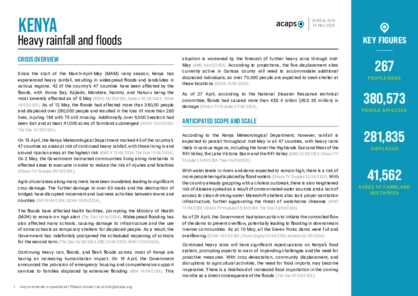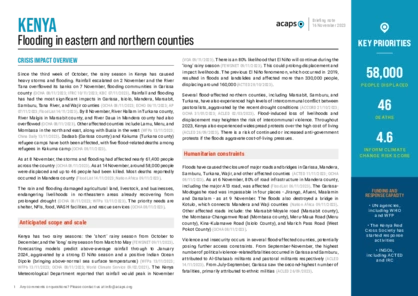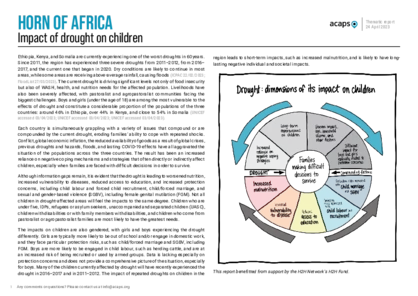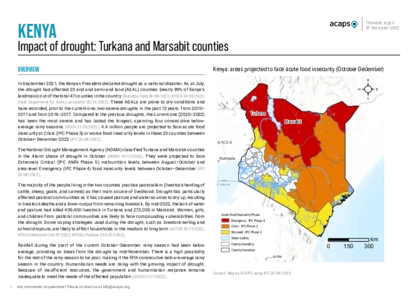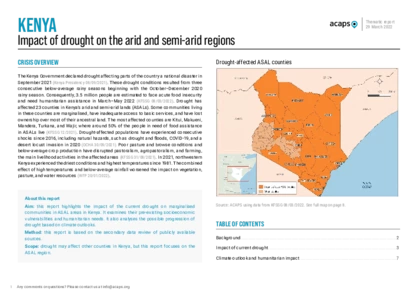Latest updates on country situation
29 April 2025
Heavy rainfall in different parts of the country, particularly Isiolo and Baringo counties, has caused flooding and displacement. By 23 April 2025, two people were reported missing and around 1,200 were displaced in Isiolo alone. The floods have raised concerns around a cholera outbreak aggravated by poor sanitation and limited access to clean water. (ECHO 23/04/2025, The Eastleigh Voice 22/04/2025)
26 November 2024
Climate conditions have triggered concurrent disease outbreaks in northern Kenya, notably malaria in Baringo, Marsabi, and Turkana counties. These arid and semi-arid regions face considerable barriers to healthcare access, including long distances to medical facilities, challenging terrain, and high transportation costs. Severe shortages of healthcare workers and critical resources, such as diagnostic tests and treatments, worsen these constraints. In Baringo county, the absence of preventive malaria interventions for over five years has worsened the outbreak. The October–November 2024 rains are expected to further heighten malaria cases, particularly in refugee-hosting Turkana county, where health infrastructure is already overstretched. Between 1 January and 3 November, more than 2,700 measles cases were recorded, a significant rise from 1,370 cases during the same period in 2023. Measles outbreaks have been reported in 17 counties, with Garissa county recording the highest number of cases, followed by Turkana, Mandera, and Kajiado. (MSF 25/11/2024, WHO 23/11/2024, Crisis24 26/11/2024)
02 July 2024
Since 25 June 2024, Kenya has witnessed a growing youth-led movement protesting against tax increases and the Finance Bill 2024. Although the President withdrew the bill on 26 June, anti-government protests have persisted. While largely peaceful, the protests have faced police use of live ammunition, killing at least 39 by 1 July according to the Kenya National Commission on Human Rights. More than 30 cases of involuntary disappearances and nearly 600 arrests of protesters, with approximately 360 injured, have been reported. Although some detained protesters have since been released, these incidents of violence heighten protection risks for those at the forefront of the protests. Physical access constraints during the protests hinder the access of aid organisations and ambulances to those in need. Red Cross staff and volunteers have also received injuries and experienced attacks on their vehicles. There are also reports of internet disruptions during the protests. (AJ 01/07/2024, Reuters 25/06/2024, The Guardian 25/06/2024, HRW 28/06/2024) [please keep three sources only]
04 June 2024
In June 2024, Kenya is grappling with a vaccine shortage amid a measles outbreak. The Bacillus Calmette-Guérin (BCG), measles, polio, rotavirus, tetanus, and other essential vaccines are unavailable in various facilities. Kakuma camp has exhausted its buffer stocks of the BCG vaccine, oral polio vaccine (OPV), and rotavirus vaccine, with current supplies projected to last one month. A similar crisis is emerging in Hagadera and Dadaab camps, where only 60 OPV doses remain. This heightens the risk of preventable outbreaks with severe consequences, including lifelong disabilities and fatalities among children. Frequent cross-border movement and nomadic lifestyles put communities along Kenya's borders, particularly in Turkana and Garissa counties, at heightened susceptibility. Refugees are at particular risk given the continuous influx of new refugees and asylum seekers from neighbouring regions. The porous borders aggravate the situation, with inadequate disease surveillance systems, particularly at the numerous informal entry points along the Somali border (IRC 04/06/2024, The Standard 02/06/2024, Nation 19/05/2024)
07 May 2024
In May 2024, tensions and unrest are escalating in Kakuma refugee camp and the neighbouring Kalobeyei integrated settlement in Turkana West following a reduction in food rations in April. The 60% reduction in food aid has triggered protests in both areas. Media reports have highlighted instances of violence, including a child being shot in Kakuma and another left injured during the unrest. Cash assistance has replaced food distributions, but many refugees express concerns about its adequacy in meeting their basic needs. Without adequate assistance, more than 270,000 refugees are at risk of malnutrition and may resort to coping mechanisms with harmful outcomes, including transactional sex and theft. (USCRI 06/05/2024, The Standard accessed 18/04/2024, The Standard 01/04/2024)
30 April 2024
As at 28 April 2024, heavy rains and flash floods had caused significant devastation across Kenya, resulting in over 100 fatalities, 29 injuries, and 21 individuals reported missing. The disaster has displaced approximately 150,300 people and affected nearly 191,000 individuals. It has also led to the loss of over 4,800 livestock, damaged 27,700 acres of croplands, and disrupted 260 businesses and 24 schools. As a result, the reopening of schools, initially scheduled for 29 April, has been postponed to 6 May. The damage has rendered impassable some essential roads, such as the Garissa-Nairobi and Dadaab-Garissa roads, aggravating the situation. The displaced population is in urgent need of humanitarian assistance, including food, water, sanitation, shelter, medical services, and NFIs. (OCHA 29/04/2024, The Guardian 29/04/2024, ECHO 30/04/2024)
15 April 2024
Since 9 April 2024, heavy rains and flash floods in Kenya have led to the death of more than 13 people, with an estimated 15,000 people displaced. The March–May rainy season has brought about intense storms, rising river levels, infrastructure damage, and livestock and property losses. Impeded road access across various regions is disrupting access to essential services, including markets and healthcare facilities. Particularly affected counties include Garissa, Kiambu, Kirinyaga, Kisumu, Kitui, Marsabit, Meru, Murang’a, Nairobi, Tana River, and Turkana, where several roads are inundated. Affected populations require shelter and increased healthcare access. Despite efforts to address immediate needs such as food, water, sanitation, shelter, medical aid, and evacuation support, persistent challenges remain. The Kenya Meteorological Department warns of continued heavy rainfall with the likelihood of flash floods in several parts of the country, including the Highlands, Rift Valley, Lake Victoria Basin, Southeastern lowlands, Coastal, Northwestern, and Northeastern regions. (OCHA 11/04/2024, VOA 12/04/2024, ECHO 12/04/2024)
current crises
in
Kenya
These crises have been identified through the INFORM Severity Index, a tool for measuring and comparing the severity of humanitarian crises globally.
KEN001 - Country level
Last updated 28/04/2025
Drivers
Drought/drier conditions
International Displacement
Floods
Crisis level
Country
Severity level
3.5 High
Access constraints
2.0
KEN002 - Refugee situation
Last updated 28/04/2025
Drivers
International Displacement
Crisis level
Country
Severity level
2.8 Medium
Access constraints
2.0
KEN003 - Drought
Last updated 28/04/2025
Drivers
Drought/drier conditions
Crisis level
Country
Severity level
3.3 High
Access constraints
2.0
Analysis products
on
Kenya
14 May 2024
Kenya: heavy rainfall and floods
DOCUMENT / PDF / 2 MB
Since the start of the March-April-May (MAM) rainy season, Kenya has experienced heavy rainfall, resulting in widespread floods and landslides in various regions. 42 of the country’s 47 counties have been affected by the floods, with Homa Bay, Kajiado, Mandera, Nairobi, and Nakuru being the most severely affected as of 6 May.
16 November 2023
Kenya: flooding in eastern and northern counties
DOCUMENT / PDF / 867 KB
Since the third week of October, the rainy season in Kenya has caused heavy storms and flooding, significantly impacting Garissa, Isiolo, Mandera, Marsabit, Samburu, Tana River, and Wajir counties. As at 8 November, the storms and flooding had affected nearly 61,400 people across the country.
24 April 2023
Horn of Africa: Impact of drought on children
DOCUMENT / PDF / 5 MB
Ethiopia, Kenya, and Somalia are currently experiencing one of the worst droughts in 60 years. The current drought is driving significant levels not only of food insecurity but also of WASH, health, and nutrition needs for the affected population.
07 December 2022
Kenya: impact of drought in Turkana and Marsabit counties
DOCUMENT / PDF / 2 MB
In September 2021, the Kenyan President declared drought as a national disaster. As at July, the drought had affected 23 arid and semi-arid land counties out of the total 47 counties in the country. 4.4 million people are projected to face acute food insecurity at Crisis (IPC Phase 3) or worse food insecurity levels in these 23 counties between October–December 2022.
31 March 2022
Kenya: Impact of drought
DOCUMENT / PDF / 726 KB
This report highlights the impact of the current drought on marginalised communities in Kenya's arid and semi-arid lands. It examines their pre-existing socioeconomic vulnerabilities and humanitarian needs. It also analyses the possible progression of drought based on climate outlooks.


